
We could go a couple of directions this morning. The New York Real Estate ruling against a former Chief Executive has a lot of folks consternated, since no one in the jury-less trial would have stipulated a fine near a half-billion dollars and intended only to penalize the presumptive nominee in an election year.
That might be what Clyde William Tombaugh thought. He had a rich and rewarding life as a professional astronomer across nearly the entire 20th Century. He was born in this month in 1906 and lived until January of 1997. So, his time nearly covered the whole revolution from horse and buggy to the lunar surface. From first powered flight in 1903 to the discussion of Y2K looming. There is some comfort he could have taken in what he accomplished in his life- he discovered the Planet Pluto, and passed before his planet was demoted from that status to only a “dwarf.”
For nearly seventy years, he was known as the discoverer of the ninth planet, the one we knew as Pluto. It was the first object to be discovered in what became known as the “Kuiper Belt” of assorted space junk.
It is a great story, since the possibility of another planet had been described by a theoretical astronomer named Percival Lowell. He had spent over a decade attempting to validate his theory that minute “wobbles” detected in the orbits of Uranus and Neptune meant they were being influenced by a large object that was a ninth planet!
Lowell had theorized the existence of a ninth planet based on the orbital irregularities, but it wasn’t until Tombaugh started using a new observation technique that Pluto was first spotted.
This new observation tool involved something called a ‘blink comparator.’ The comparator he used was installed at Lowell Observatory in Arizona and connected the two star-watchers. It had previously been used to find differences between two photographs of the night sky. The difference now was harnessed to detect a ninth planet in our solar system. Tombaugh did not live to see his discovery ejected from our solar family. In 2006, we returned to having only eight full-sized planets with one dwarf little brother.
The problem, or at least one of them, is the Kuiper Belt. That is a disc-shaped circumstellar formation of circling junk in the outer Solar System. It extends from Naptune’s orbit at 30 astronomical units (AU) to approximately 50 AUs distant from the Sun. It resembles the asteroid belt but is far larger. stretching 20 times as wide and 20-200 times as thick, so you can see the challenge. and is the home of the Five Dwarves. That is the direct cause of the demotion of what may have been the most popular former planet in this corner of our Galaxy.
At least to us!
We are undergoing a technical revolution here, and it was well in progress by 2006. Part of the technology eclipsed the capabilities of the International Astronomical. Or maybe “enhanced” is a better word, since four o=spherical objects were newly found in the Kuiper Belt, and it was decided that Pluto should leave the ranks of full planets and be redesignated a Dwarf.
The IAU demoted the much-loved Pluto from its position as the ninth full planet without fully understanding the widespread outrage that followed the change. When the announcement was made people around the world objected to the planet’s demotion on principle, saying that it altered tradition and history, rather than engaging with the scientific reasoning. So, Science did what Science has been accused of doing recently in stars, planets and pandemics. They adjusted them.
The main event of the IAU’s 2006 General Assembly was a defining moment for the rest of the Solar System as the matter was first discussed vigorously in public. The debate was fierce, since the decision involved accepting a new definition of what constitutes ‘a planet.’ What was once a loose word used to describe large round objects within the solar system was now made specific. ‘Planets’ were now defined as “celestial objects large enough to be made rounded by their gravitational orbit around the Sun” and to have cleared away neighboring planetary objects and debris.
Pluto became a Dwarf because while having enough mass to have become spherical, it is not big enough to exert its orbital dominance and clear the neighborhood surrounding its orbit.
But as we said, both Astronomers responsible for identifying Pluto’s hurtling mass had passed on to their individual eternities. So, they never new the seminal work of their professional lives would be relegated to something dwarfed by smaller spatial bodies. But now along with the eight big ones, there are five small ones, leaving us with 13 large, medium and small objects, two belts, and our own plaintive planet.
Tombaugh and Lowell might have wanted to follow the Scientific Method, wherever it takes the knowledge. But they were probably just happy to take their fame with them when they left, you know?
Copyright 2024 Vic Socotra
www.vicsocotra.com
